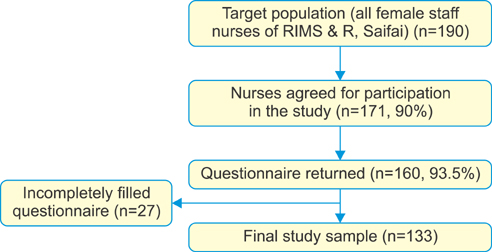J Gynecol Oncol.
2012 Jul;23(3):141-146. 10.3802/jgo.2012.23.3.141.
Awareness of cervical cancer screening among nursing staff in a tertiary institution of rural India
- Affiliations
-
- 1Department of Obstetrics and Gynaecology, Uttar Pradesh Rural Institute of Medical Sciences & Research, Etawah, India. ektasinghlhmc@gmail.com
- 2Department of Community Medicine, Uttar Pradesh Rural Institute of Medical Sciences & Research, Etawah, India.
- KMID: 2245171
- DOI: http://doi.org/10.3802/jgo.2012.23.3.141
Abstract
OBJECTIVE
To determine the baseline information about the knowledge of cervical cancer and explore attitude and practice of Pap smear screening among staff nurses.
METHODS
A pretested structured self administered questionnaire based survey was done on 205 staff nurses working in Rural Institute of Medical Sciences & Research, Saifai, Etawah, containing mostly recognition and some recall type questions about demographics, knowledge about cervical cancer, its risk factors, screening techniques, attitudes towards cervical cancer screening and its practices.
RESULTS
In this study, 74% knew that Pap smear is used for detection of cervical cancer, but only 59% knew that it can detect both cancerous as well as precancerous lesions of the cervix. Only 18% of the respondents knew about human papillomavirus vaccine. A 47% of respondents had never taken a Pap smear; 63% never referred patients for the screening. Most nurses (79%) thought that a speculum examination and Pap smear are procedures to be performed by the doctors. Among all the respondents, only 11% had ever undergone a Pap smear on themselves.
CONCLUSION
Despite knowledge of the gravity of cervical cancer and prevention by screening, attitudes and practices towards screening were negative.
Keyword
MeSH Terms
Figure
Cited by 1 articles
-
Knowledge, attitude, practice and barriers of cervical cancer screening among women living in mid-western rural, Nepal
Niresh Thapa, Muna Maharjan, Marcia A. Petrini, Rajiv Shah, Swati Shah, Narayani Maharjan, Navin Shrestha, Hongbing Cai
J Gynecol Oncol. 2018;29(4):. doi: 10.3802/jgo.2018.29.e57.
Reference
-
1. Standard & Guidelines, Cervical and breast cancer screening by VIA & CBE. 2006. New York: The United Nations Population Fund.2. Desai M. An assessment of community based cancer screening program among Indian women using the Anganwadi workers. J Obstet Gynecol Ind. 2004. 54:483–487.3. Adeleke NA, Komolafe JA. Knowledge, attitude and practice of cervical cancer screening among women of reproductive age group in Osogbo, south western Nigeria. Sex Health Matters. 2007. 8:70–73.4. Postgraduate Institute of Medical Education and Research. Guidelines for cervical cancer screening programme. Government of India-World Health Organization Collaborative Programme (2004-2005). 2006. Chandigarh, India: Postgraduate Institute of Medical Education and Research.5. National Commission on Macroeconomics and Health. Burden of disease in India. 2005. New Delhi, India: Ministry of Health & Family Welfare, Government of India.6. Hainer R. New guidelines: Pap test should start at age 21 [Internet]. 2009. cited 2012 May 30. Atlanta: Cable News Network (CNN);Available from: http://edition.cnn.com/2009/HEALTH/11/20/pap.cervical.cancer/index.html.7. Sankaranarayanan R, Budukh AM, Rajkumar R. Effective screening programmes for cervical cancer in low- and middle-income developing countries. Bull World Health Organ. 2001. 79:954–962.8. Chirenje ZM, Chipato T, Kasule J, Rusakaniko S. Visual inspection of the cervix as a primary means of cervical cancer screening: results of a pilot study. Cent Afr J Med. 1999. 45:30–33.9. Cronje HS, Parham GP, Cooreman BF, de Beer A, Divall P, Bam RH. A comparison of four screening methods for cervical neoplasia in a developing country. Am J Obstet Gynecol. 2003. 188:395–400.10. Ertem G. Awareness of cervical cancer risk factors and screening behavior among nurses in a rural region of Turkey. Asian Pac J Cancer Prev. 2009. 10:735–738.11. Sankaranarayanan R, Rajkumar R, Arrossi S, Theresa R, Esmy PO, Mahe C, et al. Determinants of participation of women in a cervical cancer visual screening trial in rural south India. Cancer Detect Prev. 2003. 27:457–465.12. Siahpush M, Singh GK. Sociodemographic predictors of pap test receipt, currency and knowledge among Australian women. Prev Med. 2002. 35:362–368.13. Bott S, Jejeebhoy S, Shah I, Puri C. Towards adulthood: exploring the sexual and reproductive health of adolescent in South Asia. 2003. Geneva: World Health Organization.14. Powe BD, Finnie R. Cancer fatalism: the state of the science. Cancer Nurs. 2003. 26:454–465.15. Denny L, Kuhn L, De Souza M, Pollack AE, Dupree W, Wright TC Jr. Screen-and-treat approaches for cervical cancer prevention in low-resource settings: a randomized controlled trial. JAMA. 2005. 294:2173–2181.16. Waller J, McCaffery K, Wardle J. Measuring cancer knowledge: comparing prompted and unprompted recall. Br J Psychol. 2004. 95(Pt 2):219–234.
- Full Text Links
- Actions
-
Cited
- CITED
-
- Close
- Share
- Similar articles
-
- Knowledge, attitude, practice and barriers of cervical cancer screening among women living in mid-western rural, Nepal
- Comparison of Health Promotion Behavior in Middle aged Rural Residents by Cancer Screening Participation
- Guidelines for the Screening of Uterine Cervical Cancer
- Health Care Utilization in Women with Cervical Cancer and Cervical Intraepithelial Neoplasia
- Related Factors to Screening or Repeat Screening for Cervical and Breast Cancer among Women


